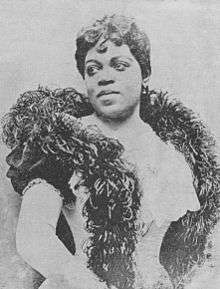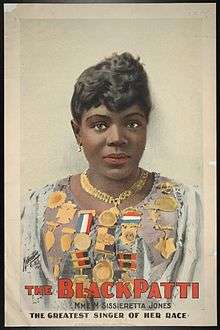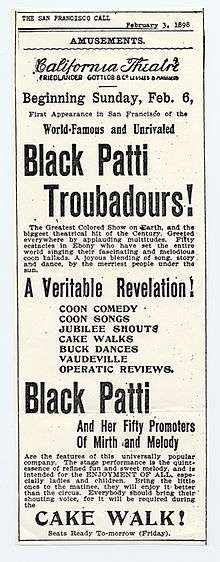Matilda Sissieretta Joyner Jones
| Matilda Sissieretta Joyner Jones | |
|---|---|
 | |
| Background information | |
| Birth name | Matilda Sissieretta Joyner |
| Also known as | The Black Patti |
| Born |
January 5, 1868 Portsmouth, Virginia, U.S. |
| Died |
June 24, 1933 (aged 65) Providence, Rhode Island, U.S. |
| Genres | grand opera, light opera, popular music |
| Years active | 1887–1915 |
Matilda Sissieretta Joyner Jones, known as Sissieretta Jones, (January 5, 1868 or 1869[1] – June 24, 1933[2]) was an African-American soprano. She sometimes was called "The Black Patti" in reference to Italian opera singer Adelina Patti. Jones' repertoire included grand opera, light opera, and popular music.[3]
Biography
Matilda Sissieretta Joyner was born in Portsmouth, Virginia, United States, to Jeremiah Malachi Joyner, an African Methodist Episcopal minister, and Henrietta Beale.[2] By 1876 her family moved to Providence, Rhode Island,[4] where she began singing at an early age in her father's Pond Street Baptist Church.[2]
In 1883, Joyner began the formal study of music at the Providence Academy of Music. The same year she married David Richard Jones, a news dealer and hotel bellman. In the late 1880s, Jones was accepted at the New England Conservatory of Music.[1] On October 29, 1885, Jones gave a solo performance in Providence as an opening act to a production of Richard III put on by John A. Arneaux's theatre troupe.[5] In 1887, she performed at Boston's Music Hall before an audience of 5,000.[2]
Jones made her New York debut on April 5, 1888, at Steinway Hall.[1] During a performance at Wallack's Theater in New York, Jones came to the attention of Adelina Patti's manager, who recommended that Jones tour the West Indies with the Fisk Jubilee Singers.[2] Jones made successful tours of the Caribbean in 1888 and 1892.[1]
In February 1892, Jones performed at the White House for President Benjamin Harrison.[2] She eventually sang for four consecutive presidents — Harrison, Grover Cleveland, William McKinley, and Theodore Roosevelt — and the British royal family.[1][2][3]

Jones performed at the Grand Negro Jubilee at New York's Madison Square Garden in April 1892 before an audience of 75,000. She sang the song "Swanee River" and selections from La traviata.[3] She was so popular that she was invited to perform at the Pittsburgh Exposition (1892) and the World's Columbian Exposition in Chicago (1893).[4]
In June 1892, Jones became the first African-American to sing at the Music Hall in New York (renamed Carnegie Hall the following year).[1][7] Among the selections in her program were Charles Gounod's "Ave Maria" and Giuseppe Verdi's "Sempre libera" (from La traviata).[1] The New York Echo wrote of her performance at the Music Hall: "If Mme Jones is not the equal of Adelina Patti, she at least can come nearer it than anything the American public has heard. Her notes are as clear as a mockingbird's and her annunciation perfect."[1] On 8 June 1892, her career elevated beyond primary ethnic communities, and was furthered when she received a contract, with the possibility of a two-year extension, for $150 per week (plus expenses) with Mayor James B. Pond, who had meaningful affiliations to many authors and musicians.[8] The company Troubadours made an important statement about the capabilities of black performers, that besides minstrelsy, there were other areas of genre and style.[8]
In 1893, Jones met composer Antonín Dvořák, and in January 1894 she performed parts of his Symphony No. 9 at Madison Square Garden. Dvořák wrote a solo part for Jones.[1]
Jones met with international success. Besides the United States and the West Indies, Jones toured in South America, Australia, India, and southern Africa.[1] During a European tour in 1895 and 1896, Jones performed in London, Paris, Berlin, Cologne, Munich, Milan, and Saint Petersburg.[9]

In 1896, Jones returned to Providence to care for her mother, who had become ill.[1] Jones found that access to most American classical concert halls was limited by racism. She formed the Black Patti Troubadours (later renamed the Black Patti Musical Comedy Company), a musical and acrobatic act made up of 40 jugglers, comedians, dancers and a chorus of 40 trained singers.[2] The Indianapolis Freeman reviewed the “Black Patti Troubadours” with the following: “The rendition which she and the entire company give of this reportorial opera selection is said to be incomparably grand. Not only is the solo singing of the highest order, but the choruses are rendered with a spirit and musical finish which never fail to excite genuine enthusiasm.[10]
The revue paired Jones with rising vaudeville composers Bob Cole and Billy Johnson. The show consisted of a musical skit, followed by a series of short songs and acrobatic performances. During the final third of each show, Jones performed arias and operatic excerpts.[9] The revue provided Jones with a comfortable income, reportedly in excess of $20,000 per year. She led the company with reassurance of a forty-week season that would give her a sustainable income, guaranteed lodging in a well-appointed and stylish Pullman car, and the ability to sing opera and operetta excerpts in the final section of the show.[8] This allowed Jones to be the highest paid African American performer of her time.[8] Jones sung passionately and pursued her career choice of opera and different repertory regardless to her lack of audience attendance.[8] For more than two decades, Jones remained the star of the Famous Troubadours, while they graciously toured every season and established their popularity in the principal cities of the United States and Canada.[11] Although their eventual fame and international tours collected many audiences, they began with a “free-for-all” variety production with plenty of “low” comedy, song and dance, and no pretense of a coherent story line.[12]
Several members of the troupe, such as Bert Williams, went on to become famous.[1] April 1908, at the Avenue Theatre in Louisville, Kentucky, an audience made up mostly of whites (segregated seating was still prevalent), accepted Madam ‘Patti’ after singing ‘My Old Kentucky Home’ with much respect and admiration, and marked “the first time that a colored performer received a bouquet at the theatre in this city”.[12] For almost ten years, racial segregation had kept Jones from the mainstream opera platform, but by singing selections from operas within the context of a hard-traveling minstrel and variety show, she was still able to utilize her gifted voice, that people of all races loved.[12] The Black Patti Troubadours reveled in vernacular music and dance.[12]
Jones retired from performing in 1915. For more than two decades, Jones remained the star of the Famous Troubadours, while they graciously toured every season and established their popularity in the principal cities of the United States and Canada.[12] She devoted the remainder of her life to her church and to caring for her mother. Jones was forced to sell most of her property to survive.[1][2] She died penniless on June 24, 1933.[2]
In 2013 Jones was inducted into the Rhode Island Music Hall of Fame.[13]
See also
References
- 1 2 3 4 5 6 7 8 9 10 11 12 13 Alexander, George (Summer 2007). "The Soprano". American Legacy..
- 1 2 3 4 5 6 7 8 9 10 "Sissieretta Jones". Women in History. Retrieved 2008-05-04.
- 1 2 3 Kwame Anthony Appiah and Henry Louis Gates, Jr., ed. (1999). "M. Sissieretta Jones". Africana: The Encyclopedia of the African and African American Experience. New York: Basic Civitas Books. p. 1065.
- 1 2 Hill, Errol; James Vernon Hatch (2003). A History of African American Theatre. Cambridge: Cambridge University Press. p. 148. ISBN 0-521-62443-6.
- ↑ Lee, Maureen D. Sissieretta Jones:" the Greatest Singer of Her Race," 1868-1933. Univ of South Carolina Press, 2013. p10
- ↑ This is the only portrait poster of an African-American performer held by the Library of Congress Performing Arts Posters collection from the period of Jones' career.
- ↑ Hudson, Rob. "From Opera, Minstrelsy and Ragtime to Social Justice: An Overview of African American Performers at Carnegie Hall, 1892-1943". The Black Past: Remembered and Reclaimed. Retrieved 2008-05-07.
- 1 2 3 4 5 Graziano, John. "The Early Life and Career of the "Black Patti": The Odyssey of an African American Singer in the Late Nineteenth Century". Journal of the American Musicological Society. 53: 543–596. doi:10.2307/831938.
- 1 2 Hill; Hatch. A History of African American Theatre. p. 149.
- ↑ Sampson, Henry (2014). Blacks in Blackface: a sourcebook on early black musical shows (2nd ed.). University of Mississippi Press. p. 1406.
- ↑ Sampson, Henry (2014). Blacks in Blackface: a sourcebook on early black musical shows (2nd ed.). The Scarecrow Press, Inc. p. 1406.
- 1 2 3 4 5 Abbott, Lynn; Seroff, Doug (2007). Ragged but right black traveling shows, "coon songs," and the dark pathway to blues and jazz. University Press of Mississippi.
- ↑ "RI Music Hall of Fame Announces 2013 Inductees". GoLocalProv.com. Retrieved 28 September 2013.
13. Lee, Maureen D. Sissieretta Jones "The Greatest Singer of her Race":1868-1933. Columbia, SC: University of South Carolina Press, 2012.
Further reading
- Abbott, Lynn; Doug Seroff (2002). Out of Sight: The Rise of African American Popular Music, 1889–1895. Jackson, Miss.: University Press of Mississippi. ISBN 1-57806-499-6.
- Donnelley Lee, Maureen (2012). Sissieretta Jones: "The Greatest Singer of Her Race", 1868–1933. University of South Carolina Press. ISBN 1-61117-072-9.
- Nettles, Darryl Glenn (2003). African American Concert Singers Before 1950. Jefferson, N.C.: McFarland & Co. ISBN 0-7864-1467-7.
- Story, Rosalyn M. (1990). And So I Sing: African-American Divas of Opera and Concert. New York: Warner Books. ISBN 0-446-71016-4.
External links
- History's Unsung Opera Star, National Public Radio, June 11, 2007
- Matilda Sissieretta Joyner Jones at Encyclopædia Britannica
- Sissieretta Jones at the African American Registry
- Sissieretta Jones at Black History Pages
- Sissieretta Jones at The Black Past
- Sissieretta Jones at Find a Grave
- Sissieretta Jones: The Black Patti From the Carnegie Hall Archives